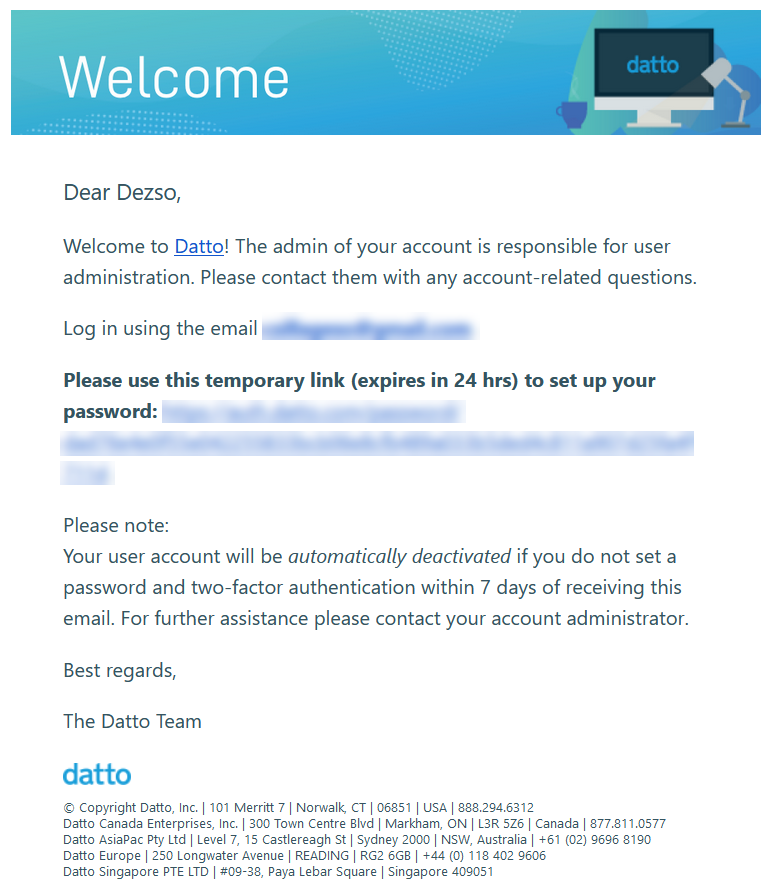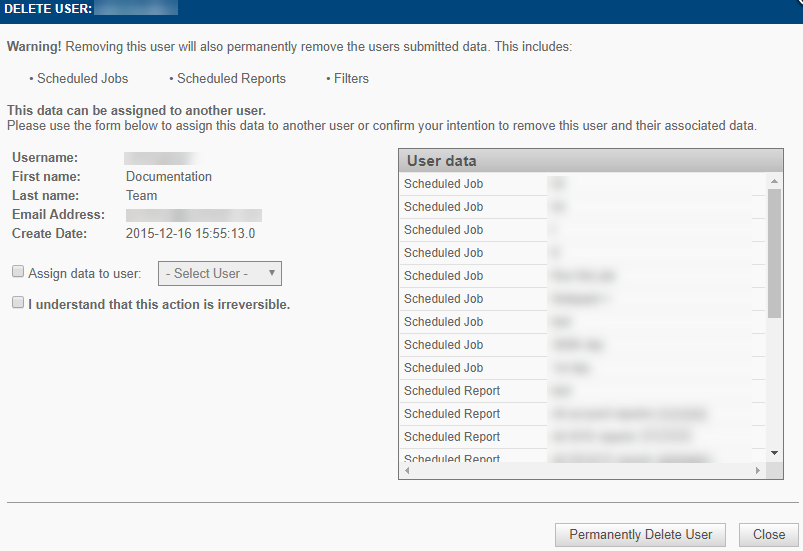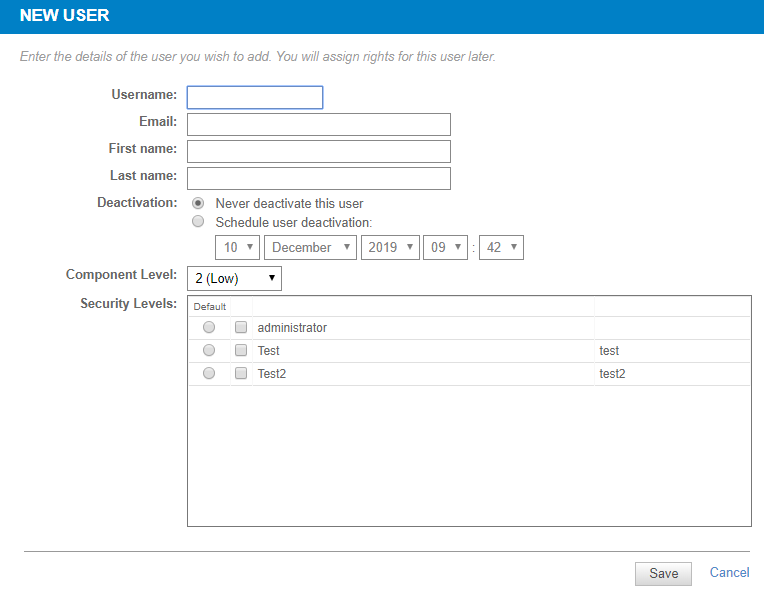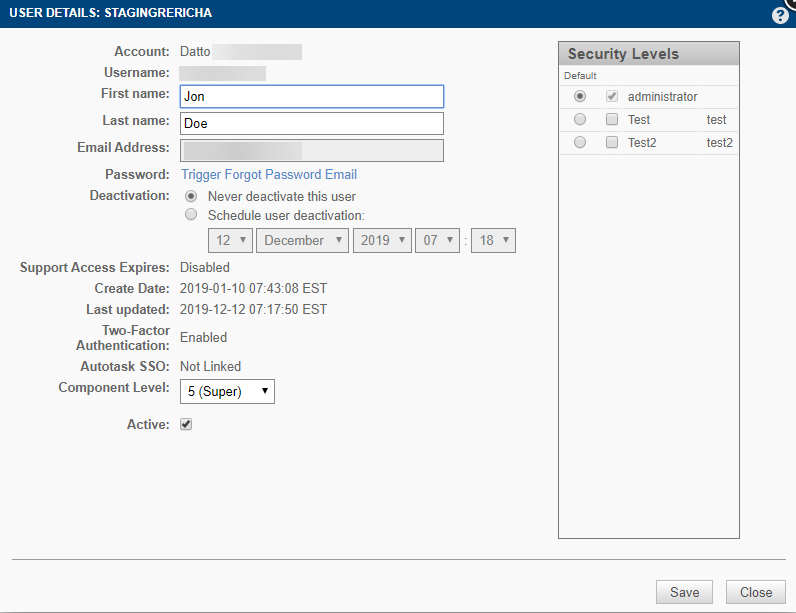Users - Legacy UI
PERMISSIONS Administrator
NAVIGATION Legacy UI > Setup > Users
Refer to Users.
Users in Datto RMM are individuals with a user account. You can add and manage users on the Setup > Users tab.
On this tab, you can toggle between two views as follows:
- The Users view displays a list of all users that have been set up in your Datto RMM account. Here, you can add and manage users.
- The Activity Log view directs you to the Activity Log in the New UI where you can view all user activities. Refer to Activity Log.
NOTE All activity logging is now available exclusively in the New UI.
By default, the Users view is displayed.
How to...
The following information is displayed:
| Field | Description |
|---|---|
| Selection check box | Click the check box in the header row to select all rows, or click one or more rows to perform an action. |
| Username | Click the hyperlink of the user's name to open the User Details page for that user. Refer to Edit a user. |
| Name | First and last name of the user. |
| Deactivation | Indicates whether the user account is set to expire on a certain date at a certain time. Refer to Deactivation. |
| Security Levels | Lists all security levels that are associated with this user. |
| Component Level | Determines which components can be viewed by the user. Refer to Component Level. |
| Default to New UI | A toggle that will make the New UI the default interface for this user. Refer to Main features in Datto RMM. NOTE Ensure you have at least View permission for Global > Dashboard to prevent an Access denied error message when you log in to your account. Refer to Permissions. |
| Administrator | A toggle that will instantly add or remove the user's Administrator access. Refer to Security levels - Legacy UI in the legacy UI and Security levels in the New UI. |
The following Action bar icons are available:
| Icon | Name | Description |
|---|---|---|
|
|
Toggle inactivate/activate user | Refer to Inactivate or activate a user. |
|
|
View user activity | Select one or more users and click the icon. The Activity Log view will direct you to the Activity Log in the New UI where you can view all user activities. Refer to Activity Log. |
|
|
Export to CSV | Allows you to export a list of the selected users and their attributes in .CSV format. Make sure to select/clear the columns you want to include/exclude in the export (all columns are selected by default). Passwords and API Secret Keys are not exported. NOTE Microsoft Excel is unable to properly display UTF-8 compliant CSV files when they contain non-English characters. |
|
|
Refresh | Refreshes the current view. |
- In the Search field, begin typing a Username or Name.
As you type, the search results are narrowed to match your search string.
- To display the full list, delete the search criteria.
| Field | Description |
|---|---|
| Username | Enter a unique username. It must be unique not only on your platform but also across all platforms. Best practice is to use an email address. |
| Enter the user's email address. | |
| First name, Last name | Enter the user's first and last name. |
| Deactivation | Select one of the following options: • Never deactivate this user. • Schedule user deactivation: specify when you want the user account to expire. Select a date and a time. |
| Component Level | Determines which components the user can view in the Component Library. Refer to Managing components - Legacy UI in the legacy UI and Component Library in the New UI. Select a number between 1 (Basic) and 5 (Super). 2 (Low) is selected by default. EXAMPLE For example, a user whose component level is set to Super (5) will be able to view all components in the Component Library; while a user whose component level is set to Medium (3) will only be able to view components with a component level of Medium (3), Low (2), or Basic (1). When editing a component's component level, a user can only select a component level that is available to them based on their component level in their user settings. |
| Security Levels | Select the user's default security level by clicking the radio button next to the security level. The default security level will automatically be assigned to the user when they log in to Datto RMM. You may assign a user more than one security level by selecting the check box next to another security level. A user with more than one security level can switch to any of them for the duration of their login session. For information about creating and managing security levels, refer to Security levels - Legacy UI in the legacy UI and Security levels in the New UI. For information about switching security levels, refer to Switch security levels (legacy UI and Agent Browser) and Current Security Level (New UI). |
- Click Save to create the user.
NOTE An email from noreply@datto.com will be sent to the new user's email address so that they can complete the login process. The email will contain a temporary link for the user to log in and change their password. The link will expire after 24 hours, and the user account will get deactivated if the user does not configure a password and two-factor authentication within seven days of receiving the email.
- Click the username of the user you wish to edit. The User Details page will open.
- Edit the user details. For field descriptions, refer to Add a user.
- If the user needs to reset their password, click the Trigger Forgot Password Email link. Refer to Trigger another user's password reset.
- View whether or not the user's support access is enabled and when it expires. Refer to Support Access - Legacy UI in the legacy UI and Support Access in the New UI.
- View the date and time that the user was created and last updated.
- View whether two-factor authentication is enabled or disabled. To trigger a reset email for a user, refer to Trigger a 2FA reset email for a user.
- If your Datto RMM account has been integrated with Autotask and the Single Sign-On (SSO) option has been enabled, the Autotask SSO field will be displayed on the User Details page to indicate whether the user account is Linked or Not Linked to an Autotask user profile via SSO.

NOTE If you hover over the word Linked, the Autotask user ID will be displayed.
For further information about SSO, refer to Configure SSO.
- If access to the Datto RMM API has been enabled for your Datto RMM account, you will see API-related fields on the User Details page. You can generate, regenerate, or delete the API keys. For more information, refer to Activate the API.
- To inactivate the user, clear the Active check box.
- To updated the user's security levels, refer to Security Levels.
- Click Save to save the changes.
On the User Details page, click Trigger 2FA reset email. Click OK at both confirmation messages; the first confirms that you wish to send the email to the specified user, and the second confirms that the reset has been requested.
NOTE If the user has not yet logged in, the reset request will be unsuccessful, and the user will not receive an email.
For more information about 2FA, refer to Two-factor authentication - Legacy UI.
You have three options to inactivate or activate a user. Follow the steps of the first method below:
- Navigate to Setup > Users.
- Select the user(s) in question and click the Toggle inactivate/activate user icon
 from the Action bar.
from the Action bar.
- Confirm whether you want to inactivate / activate the user(s).
You may also inactivate or activate a user by following these steps:
- Navigate to Setup > Users.
- Click on the name of the user you wish to edit.
The third option is to inactivate a user on a certain date in the future. Refer to Deactivation.
The Delete user ![]() icon becomes visible when you hover over a user. Click the icon and a pop-up window appears that displays the user's details as well as a list of their associated data. Associated data includes scheduled jobs, scheduled reports, filters, tickets, ticket monitors, or ticket notes.
icon becomes visible when you hover over a user. Click the icon and a pop-up window appears that displays the user's details as well as a list of their associated data. Associated data includes scheduled jobs, scheduled reports, filters, tickets, ticket monitors, or ticket notes.

NOTE If at the time of deletion, a Datto RMM user account is linked to an Autotask user profile via the Autotask Integration, the link will be removed. The Autotask user can then link their user profile to another Datto RMM user account.
IMPORTANT The user's associated data will be permanently deleted unless it is first reassigned to another user. When reassigning associated data to another user, you may only select another user that has the same or higher component level than the user you are deleting. This ensures that the user will have the required permissions to perform actions on the associated data being assigned to them.
Assign associated data to another user
Select the Assign data to user check box on the pop-up window, then select a user from the drop-down menu. 
Select the I understand that this action is irreversible check box and then click the Permanently Delete User button. If the deleted user's associated data was reassigned, it will be available in the recipient user's account. Otherwise, it will be permanently deleted along with the user.

 displayed next to the user's name.
displayed next to the user's name.




